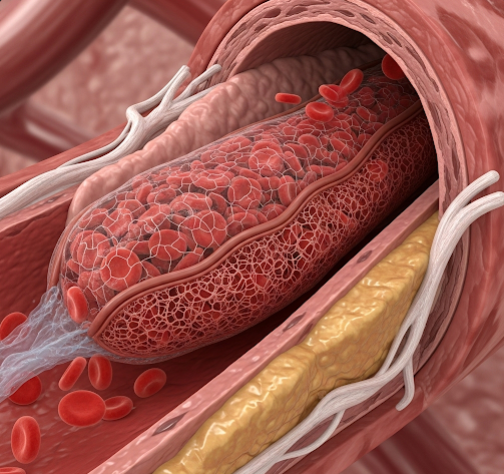Overview
Thrombosis is the formation of a blood clot within a blood vessel, which can obstruct blood flow and lead to serious health complications. It can occur in veins (venous thrombosis) or arteries (arterial thrombosis) and is a major contributor to conditions such as stroke, heart attack, and pulmonary embolism. In South Korea, advanced diagnostic technologies and comprehensive treatment strategies allow for rapid identification and management of thrombosis, reducing morbidity and mortality. Korean hospitals emphasize multidisciplinary care, including anticoagulation therapy, interventional procedures, lifestyle modification, and preventive measures.
What is Thrombosis?
Thrombosis refers to the pathological formation of a blood clot (thrombus) inside a blood vessel, which can partially or completely block blood flow. It is classified into:
- Venous thrombosis: Clots form in veins, commonly in the deep veins of the legs, known as deep vein thrombosis (DVT)
- Arterial thrombosis: Clots form in arteries, potentially causing heart attacks, strokes, or limb ischemia
Blood clots can be life-threatening if they dislodge and travel to the lungs (pulmonary embolism) or brain (ischemic stroke). In Korea, vascular specialists, hematologists, and interventional radiologists collaborate to diagnose and treat thrombosis promptly, minimizing complications and preserving organ function.
Symptoms
Symptoms of thrombosis vary depending on the location of the clot:
Deep vein thrombosis (DVT):
- Swelling in one leg or arm
- Pain or tenderness, often in the calf
- Warmth and redness over the affected area
- Skin discoloration in severe cases
Pulmonary embolism:
- Sudden shortness of breath
- Chest pain, particularly with deep breathing
- Rapid heart rate or palpitations
- Cough, sometimes with blood
Arterial thrombosis:
- Sudden pain or numbness in limbs
- Cold or pale extremities
- Weak or absent pulse in affected area
- Organ-specific symptoms such as stroke (weakness, speech difficulty) or heart attack (chest pressure, radiating pain)
Early recognition of these symptoms and immediate medical attention are essential to prevent serious complications.
Causes
Thrombosis occurs due to abnormalities in blood flow, vessel wall integrity, or blood composition—a concept known as Virchow’s triad:
- Hypercoagulability: Increased tendency of blood to clot due to genetic conditions, cancer, pregnancy, or certain medications
- Stasis: Reduced blood flow caused by prolonged immobility, surgery, or heart failure
- Endothelial injury: Damage to the blood vessel wall from trauma, infection, or atherosclerosis
Additional contributing factors include obesity, smoking, dehydration, hormone therapy, and chronic illnesses. Korean hospitals use advanced diagnostic tools to identify underlying causes, guiding tailored preventive and therapeutic strategies.
Risk Factors
Several factors increase the risk of developing thrombosis:
- Age over 60 years
- Sedentary lifestyle or prolonged immobilization (long flights, bed rest)
- Surgery or trauma, especially orthopedic procedures
- Obesity or metabolic syndrome
- Cancer or chemotherapy
- Smoking or excessive alcohol use
- Hormonal therapy, including oral contraceptives
- Genetic disorders such as Factor V Leiden mutation or prothrombin gene mutation
- Pregnancy or postpartum period
Korean clinicians assess individual risk factors to implement preventive measures, including anticoagulation therapy when necessary.
Complications
If untreated, thrombosis can lead to severe, sometimes fatal, complications:
- Pulmonary embolism: Life-threatening blockage of pulmonary arteries
- Stroke: If arterial clots block brain circulation
- Heart attack: Clots in coronary arteries can damage heart tissue
- Chronic venous insufficiency: Long-term swelling and pain in legs after DVT
- Post-thrombotic syndrome: Persistent leg pain, swelling, and skin changes
- Organ damage: Reduced blood supply can impair kidney, liver, or limb function
Early diagnosis and intervention in South Korea significantly reduce the risk of these complications.
Prevention
Preventive strategies for thrombosis focus on lifestyle modification, risk assessment, and medical interventions:
- Mobility and exercise: Regular movement, especially during long travel or hospitalization
- Hydration: Adequate fluid intake to prevent blood thickening
- Weight management: Maintaining healthy body weight to reduce pressure on veins
- Smoking cessation: Reduces clotting risk and improves cardiovascular health
- Medication adherence: Anticoagulants for high-risk individuals or post-surgery patients
- Compression therapy: Graduated compression stockings to improve blood flow in legs
- Regular monitoring: For patients with chronic illnesses or genetic predispositions
Korean healthcare programs emphasize patient education and community awareness to prevent thrombotic events.
Treatment Options in Korea
Thrombosis treatment in South Korea is tailored based on clot type, location, and patient health:
Diagnosis:
- Physical examination and assessment of risk factors
- Ultrasound or Doppler studies for DVT
- CT or MRI angiography for arterial clots or pulmonary embolism
- Blood tests to assess coagulation status and underlying disorders
Medical Treatments:
- Anticoagulants: Medications such as warfarin, heparin, or direct oral anticoagulants (DOACs) to prevent further clot formation
- Thrombolytic therapy: Medications to dissolve existing clots in severe cases
- Pain management and supportive care for symptomatic relief
Interventional Treatments:
- Catheter-directed thrombolysis: Minimally invasive procedure to remove clots in veins or arteries
- Surgical thrombectomy: Removal of clots in critical cases
- Placement of filters: Inferior vena cava (IVC) filters to prevent clots from reaching the lungs in high-risk patients
Supportive Care and Rehabilitation:
- Monitoring for complications and recurrence
- Lifestyle counseling including diet, exercise, and smoking cessation
- Long-term anticoagulation management for patients with recurring or high-risk thrombosis
South Korea’s advanced vascular and hematology centers integrate diagnosis, interventional procedures, and follow-up care to ensure effective treatment and prevent recurrence, improving survival rates and patient quality of life.













